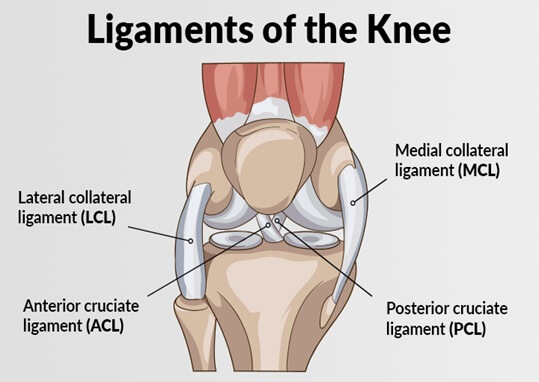Torn ligaments are one of the most common knee injuries – with the ACL and MCL in particular.
What are Your ACL and MCL?
Ligaments are strong bands of tissue that connect bones to one another and add stability and strength to a joint.
The medial collateral ligament (MCL) and anterior cruciate ligament (ACL) are the most commonly injured ligaments in the knee.

The medial collateral ligament (MCL) is located on the inner aspect, or part, of your knee, but it’s outside the joint itself.
The MCL connects the top of the tibia, or shinbone, to the bottom of the femur, or thighbone. A blow to the outside of the knee can cause the ligament on the inside of the knee (the MCL) to stretch and possibly tear. This is more common when playing a contact sport such as football or soccer. It could also happen as a result of an accident where there is a force applied to the outside of the knee.
MCL injuries are extremely painful. They can be categorized by the feeling of joints being “loose” or even displaced. While one may be able to walk after sustaining an MCL injury, the knee feels unstable and may catch during movement.
The anterior cruciate ligament (ACL) stabilizes your knee, a tear of the ACL is one of the most commonly occurring injuries in sports. A sudden twist of the knee or a dislocation of the joint could cause a pull or tear of the ACL. This could happen anywhere, including playing a sport, while running, or during a car accident.
Tearing the ACL can cause pain and swelling. Ignoring a torn ACL can potentially lead to further injury.
At Ohio Healthcare Partners in Fairlawn, Ohio we treat ACL and MCL injuries and partial tears.
ACL Injury Symptoms
- A popping sound as soon as the tear occurs
- Swelling of the knee (generally happens within six hours of injury and could be quite severe)
- Pain, especially when walking, twisting, or turning on your injured leg
- Feeling that your knee is unstable as if it’s going to give out from underneath you
MCL Injury Symptoms
The symptoms of an MCL injury are similar to symptoms of other knee problems. Our skilled and experienced medical staff can examine your knee to determine the problem.
The symptoms of an MCL injury may include:
- a popping sound upon injury
- pain and tenderness along the inner part of your knee
- swelling of the knee joint
- a feeling that your knee is going to give out when you put weight on it
- locking or catching in the knee joint
Diagnosis of ACL and MCL Injury
An ACL or MCL tear needs to be examined by a medical professional like Sara Klintworth – CNP, at Ohio Healthcare Partners.
Jessica will review your medical history and ask how you injured yourself. The physical exam typically includes observing your knee’s range of movement and looking for any knee instability.
X-rays or MRIs also may be conducted to diagnose either ACL or MCL injuries.
Ohio Healthcare Partners in Fairlawn provides top quality treatment of knee injuries!
Treatment of an ACL and MCL injury
Treatment for an ACL or MCL injury depends on the extent of the injury and the patient’s specific goals and needs.
Non-Surgical Treatment Options for ACL and MCL Injuries available at Ohio Healthcare Partners include the following:
Regenerative Therapy
Platelet-Rich Plasma Injections/PRFM
Platelet-rich plasma (PRP) has been used since the 1970s in medicine for multiple purposes. The last decade has seen a tremendous focus on PRP applications in musculoskeletal medicine. The potential for PRP to promote tissue healing following injury or disease is attractive to many physicians, researchers, and patients alike.
- Platelet-rich plasma (PRP) injections administer concentrated platelets from the patient’s own blood into damaged cartilage and tendons to reduce pain and to aid in the healing process.
- PRP rebuilds these tissues and can be used for common tendon injuries, such as tennis elbow, and to repair cartilage due to osteoarthritis or other damage.
- PRP injections consist of extracting a blood sample, concentrating the platelets, and injecting them into injured areas of the body.
- PRP injections are sometimes performed in a series, but many patients only require one injection to see results.
Amniotic Fluid Matrix Allograft*
This new breakthrough treatment option provides pain relief and healing without the risks of surgery, general anesthesia, hospital stays, or prolonged recovery and downtime from life.
- Acellular, frozen, non-irradiated, 100% pure amniotic fluid matrix allograft
- Retains its bioactivity with more than 200 growth factors proven present
- Membrane and chorion free
- Able to be injected through as small as a 30 gauge needle
Umbilical Cord Matrix / Wharton’s Jelly Allograft*
Umbilical Cord Matrix/Wharton’s Jelly Allograft contains growth factors and an abundant amount of live nucleated cells, including mesenchymal stem cells that secrete anti-inflammatory and immunomodulatory properties that optimize the cellular environment in a joint to assist in advanced healing.
- Donors are selected following an intensive and complete medical review and pre-natal evaluation prior to delivery
- Contains a dynamic environment consisting of a variety of growth factors, cytokines, scaffolding, hyaluronic acids, mesenchymal stem cells, and chemokines
- Derived exclusively from the umbilical cord after healthy delivery of a baby
- Immune-privileged so there is no chance of rejection.
As you recover from your injury, the goal is to regain strength in your knee and prevent further injury.
We combine all of our knee therapy treatment plans with a combination of comprehensive exercises, chiropractic care, massage, and CORRECT knee bracing to achieve maximum results with our program!
To learn more about our Knee Pain Treatment Options, contact our team at Ohio Healthcare Partners in Fairlawn.



